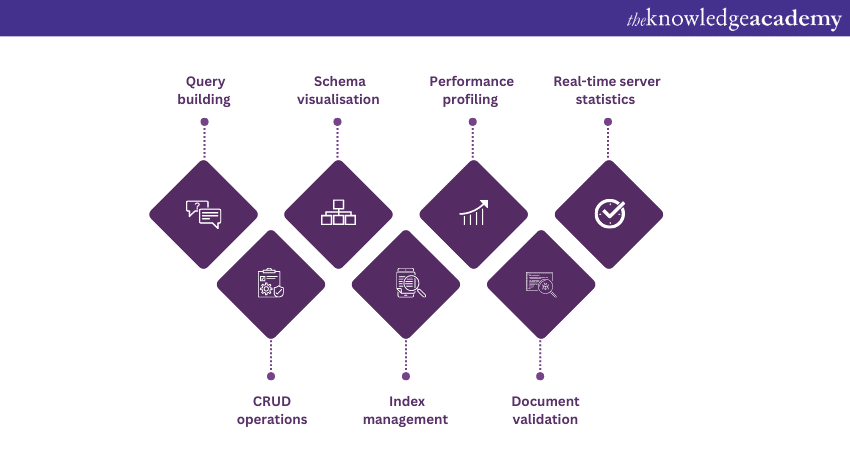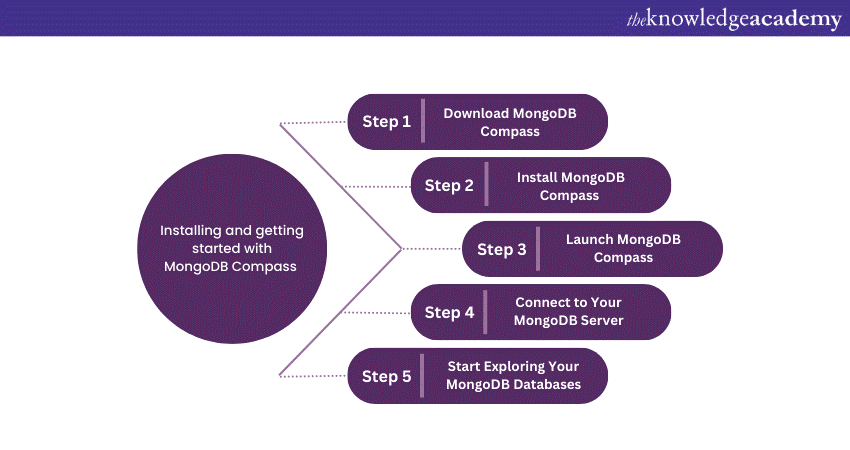We may not have the course you’re looking for. If you enquire or give us a call on +44 1344 203 999 and speak to our training experts, we may still be able to help with your training requirements.
Training Outcomes Within Your Budget!
We ensure quality, budget-alignment, and timely delivery by our expert instructors.

As MongoDB, a document-oriented NoSQL Database, continues to rise in popularity due to its scalability and flexibility, there is a growing need for a comprehensive, user-friendly graphical user interface (GUI) to facilitate interactions with MongoDB Databases. Enter MongoDB Compass, a sophisticated GUI tool tailored for MongoDB. In this blog, we will delve into what is MongoDB Compass, exploring its features, advantages, and how to get started with it.
Table of Contents
1) Introduction to MongoDB Compass
2) Features of MongoDB Compass
a) Query building
b) Schema visualisation
c) Performance profiling
d) Real-time server statistics
e) CRUD operations
f) Index management
g) Document validation
3) Installing and getting started with MongoDB Compass
4) Advantages of using MongoDB Compass
5) Conclusion
Introduction to MongoDB Compass
Before we discuss MongoDB Compass, let's quickly touch upon MongoDB. MongoDB is a source-available, cross-platform, document-oriented Database program. Classified as a NoSQL Database, it employs JSON-like documents with optional schemas and is known for its ability to manage large amounts of data while ensuring high availability and easy scalability.
MongoDB Compass is the official GUI for MongoDB. It provides a graphical view of your MongoDB schema without needing the use of Query language. With MongoDB Compass, you can explore and interact with your data, understand the distribution of values in your schema, and perform various operations like building queries, Indexing, and more. It acts as a bridge between non-technical and technical stakeholders by providing a clear view of the data and its structure.
Master MongoDB for app and web development – register for our MongoDB Developer Training now!
Features of MongoDB Compass
MongoDB Compass is an impressive tool packed with an array of features aimed at enhancing the user's interaction with MongoDB Databases. It simplifies the process of managing your Databases, enabling you to execute functions and get insights from your data more efficiently and effortlessly. The following are the primary features of MongoDB Compass:

Query building
The Query builder in MongoDB Compass serves as a powerful tool for users to construct and run queries against their Database. It has a user-friendly, point-and-click interface that reduces reliance on the command-line interface for constructing queries. This feature helps users - especially those new to MongoDB - to build complex queries without having to master MongoDB's Query language. Additionally, MongoDB Compass allows you to filter and sort data, view Query performance statistics, and interact with Query results in a full-featured editing environment.
Schema visualisation
Understanding the schema of your Database is crucial when working with MongoDB, and MongoDB Compass makes this easy with its schema visualisation feature. This feature provides a comprehensive view of your data's structure, the types, ranges, and distributions of fields in your data. It does not only give you an overall summary of your schema but also offers deep insights into the documents within the collections. This visual representation of your schema can help identify errors, redundancies, or irregularities in your data.
Performance profiling
Performance profiling is another key feature that MongoDB Compass offers. It provides a deep understanding of the performance characteristics of your Database. With this feature, you can explain plans which outline the Query execution process. It aids in uncovering performance bottlenecks, enabling you to optimise your queries for better performance. It provides a visual explanation of your Database operations, allowing you to identify slow-running queries and improve your overall Database performance.
Real-time server statistics
Real-time server statistics is a feature that allows users to monitor their MongoDB instances in real time. MongoDB Compass presents users with live server statistics, which include details about operation execution times, memory usage, and other operational metrics. This information can help users understand how their Database is being utilised, allowing them to anticipate potential issues before they evolve into significant problems.
CRUD operations
MongoDB Compass allows users to perform Create, Read, Update, and Delete (CRUD) operations right from the GUI. This provides a more visual, interactive way to manipulate the data, making it easier for users who are not comfortable using MongoDB's shell command interface.
Index management
Indexes are crucial in MongoDB for Query efficiency. MongoDB Compass comes with an intuitive interface for managing Indexes. It allows you to create, delete, and view Indexes without having to write commands. It also provides a visual representation of the Indexes, making it easier to understand their impact on your Database performance.
Document validation
Document validation is another powerful feature that MongoDB Compass offers. It allows you to create and modify validation rules for your collections. This feature helps to ensure data consistency by enforcing rules on the type and shape of the data.
Master your Cloud Database Skills today by signing up for our Amazon DocumentDB with MongoDB Course!
Installing and getting started with MongoDB Compass
Now that we know what is the use of MongoDB Compass, we will tell you how to install and how to use MongoDB Compass. Whether you're an experienced developer or a beginner dabbling in Database management, setting up MongoDB Compass is a straightforward task. Follow the steps outlined below to install MongoDB Compass and start exploring your MongoDB Databases with this powerful GUI tool.

Step 1: Download MongoDB Compass
The first step is to download the appropriate MongoDB Compass installer for your operating system. You can find the latest release on the MongoDB website's download page. The tool is available for Windows, macOS, and Linux Operating Systems. Simply select the version that matches your system specifications.
Step 2: Install MongoDB Compass
Once you've downloaded the installer, the next step is to run it. Here's how to proceed based on your operating system:
1) Windows: Double-click on the installer file and follow the on-screen instructions. You'll be guided through the setup process. When prompted, it's generally best to keep the default settings.
2) macOS: Open the .dmg file and drag the MongoDB Compass application to your Applications folder.
3) Linux: Installation varies depending on your Linux distribution. Typically, you would use your package manager to install the .deb or .rpm file that you downloaded.
Step 3: Launch MongoDB Compass
After installing MongoDB Compass, you can launch it like any other application on your system. Upon opening MongoDB Compass for the first time, you'll be greeted by the 'Connect' screen, where you can configure the connection to your MongoDB server.
Step 4: Connect to Your MongoDB Server
To connect MongoDB Compass to your MongoDB server, you'll need to input your connection details. If you're using a local MongoDB instance, you can often use the default settings (Server: localhost, Port: 27017). If you're connecting to a remote MongoDB server or using MongoDB Atlas, you'll need to input the provided connection string. Upon filling in the necessary details, click 'Connect' to establish a connection with your MongoDB server.
Step 5: Start Exploring Your MongoDB Databases
Once connected, you'll be presented with a list of your MongoDB Databases. You can click on a Database to view its collections, and from there, you can explore individual documents.
Using the left-hand menu, you can also access the various MongoDB Compass features discussed earlier, such as Query building, schema visualisation, performance profiling, and more.
Advantages of using MongoDB Compass
Using MongoDB Compass to interact with your MongoDB Databases brings numerous advantages. It's a user-friendly, visual tool that simplifies complex tasks and accelerates productivity, enabling both technical and non-technical users to engage with data effectively. Let's delve into the significant advantages of using MongoDB Compass:
Simplified Database interaction
One of the main advantages of MongoDB Compass is that it simplifies the interaction with MongoDB Databases. It offers a graphical interface, allowing users to interact visually with their data rather than using the MongoDB shell, which is command-line based. This allows even non-technical stakeholders to view, understand, and interact with the Database without having to understand MongoDB's Query language.
Improved Query development
MongoDB Compass has a powerful Query builder that enables users to create queries using a point-and-click interface. This helps users, especially beginners, in creating complex queries without having to master MongoDB's Query language. It provides an interactive way to build and test queries, greatly improving the Query development process.
Enhanced data visualisation
Visualisation is a powerful tool for the proper understanding of data. MongoDB Compass offers schema visualisation, providing a graphical representation of your data. This helps users understand their data structure, and the types, ranges, and distributions of fields in their data. It gives a visual representation of data and metadata that makes it easier to spot trends, anomalies, and patterns in the data.
Real-time performance monitoring
MongoDB Compass provides real-time server statistics, allowing users to monitor their MongoDB instances as they run. This helps in proactive issue detection and remediation, preventing potential problems before they become serious.
Efficient Index management
Indexes are a crucial aspect of MongoDB for enhancing the speed of data retrieval operations. MongoDB Compass simplifies the process of managing Indexes. It provides an intuitive interface for creating, viewing, and deleting Indexes, reducing the reliance on writing commands and thus enhancing productivity.
Improved data integrity
MongoDB Compass allows you to define document validation rules, improving data integrity by enforcing certain standards on the data stored within your MongoDB Databases. By defining these rules, you ensure consistency in the data that is stored, making data retrieval and analysis tasks more predictable and accurate.
Empowerment of non-technical stakeholders
One of the significant advantages of MongoDB Compass is that it empowers non-technical stakeholders to interact with and understand the Database. Its graphical interface and data visualisation tools allow individuals without extensive Database training to view and comprehend data more easily.
Enhanced productivity
MongoDB Compass offers features like Query auto-completion and drag-and-drop Query building, enhancing productivity by making common tasks faster and easier. It reduces the need to remember specific syntax or commands, allowing users to focus more on understanding their data and less on the mechanics of Querying.
Conclusion
To sum it up, MongoDB Compass is a powerful tool for anyone interacting with MongoDB Databases, be they developers, Database administrators, or other stakeholders. Its user-friendly interface and insightful visualisations make managing MongoDB Databases a breeze. So, regardless of whether you are already working with MongoDB or just getting started, MongoDB Compass is a tool worth exploring.
Frequently Asked Questions
Upcoming Programming & DevOps Resources Batches & Dates
Date
 Introduction to HTML
Introduction to HTML
Fri 24th Jan 2025
Fri 28th Mar 2025
Fri 23rd May 2025
Fri 25th Jul 2025
Fri 26th Sep 2025
Fri 28th Nov 2025







 Top Rated Course
Top Rated Course



 If you wish to make any changes to your course, please
If you wish to make any changes to your course, please


